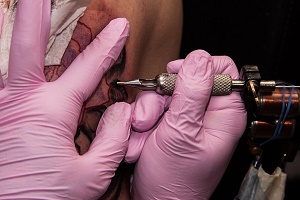 The delivery of pigments into the skin with a needle device; there are many similarities between conventional tattooing, permanent make-up and scalp micropigmentation, but there are important and distinct differences.
The delivery of pigments into the skin with a needle device; there are many similarities between conventional tattooing, permanent make-up and scalp micropigmentation, but there are important and distinct differences.
Penetration
The scalp micropigmentation practitioner will deliver the pigments into the skin to replicate hair follicles in the form of dots in areas of hair loss on the scalp. During a scalp micropigmentation procedure these are placed at a much more shallow depth, just under the surface of the skin, than commonly done during a conventional tattooing process where they are placed into the middle dermis below the epidermis.
It is important that the pigments are not placed too deeply as the ‘dots’ become indistinct as they spread. A smaller needle will not compensate for an incompetent or inexperienced practitioner. However, their superficial placement means that they are more likely to be affected by UV radiation and degrade over time, which is why it is crucial that tattoo ink is not used as it is very different to the pigments employed in a scalp micropigmentation procedure.
Pigments
During a scalp micropigmentation procedure, specially blended pigments are used that are different to those used in both conventional tattooing and permanent make-up. The pigments used in scalp micropigmentation contain very low levels of heavy metals and aren’t composite so won’t separate into blues and greens over time.
Purpose
One of the essential differences between scalp micropigmentation and conventional tattoo is the end result that the clients wishes to achieve. A tattoo is a piece of art, usually displayed for both the wearer and others to appreciate, whereas a scalp micropigmentation treatment aims to create the illusion of a closely-shaved scalp, replicated the appearance of the hair follicles. A good SMP result is one where no one is any the wiser.
Scalp micropigmentation is not a medical procedure, but a high level of training, experience and expertise is required to produce natural, great looking results.
